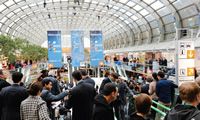Exhibitors reported numerous enquiries and intense negotiations with visitors from around the world, signalling renewed buoyancy in the international plastics market. Chairman of K2013’s Exhibitors Advisory Board, Ulrich Reifenhäuser, was delighted with results: ‘We hadn’t expected such willingness to invest,’ he said. ‘The innovative products and applications premièred at K2013 were met with great interest and many contracts were signed. Plastics manufacturers demonstrated that they’re extending capacities and investing in new technologies to sharpen their competitive edge. We confidently anticipate strong post-fair business and continuing growth in our sector.’
This view was echoed throughout the fair and shared by the 3 200 exhibitors, many of whom commented positively on the number of international visitors and the presence of senior decision makers.
Of the 218 000-plus trade visitors, just under half the foreign contingent came from outside Europe and, as expected, visitors from Asia and India accounted for the largest groups. Visitors from Indonesia, Iran, Japan and Taiwan were also numerous and there was a gratifying increase in the number of South African visitors – around 2 000 in total.
In a sector driven by the need to manufacture in an environmentally-responsible yet cost-effective way, solutions for saving resources and energy dominated product launches.
With some 1 900 exhibitors, the machinery and plant construction sector was a prime focus. For 42% of polled visitors, raw and ancillary materials were of interest, while 22% directed their attention to semifinished goods and technical components.
Overall, visitors to K2013 gave top marks to the breadth of products on show in the 19 halls, with 96% confirming they’d achieved their goals.
‘Once again it’s clear that K remains the most important event in the plastics and rubber industry,’ commented Werner Dornscheidt, president and CEO of Messe Düsseldorf. ‘This is where new technologies are premièred alongside mature developments, and this is where orders are placed.’










